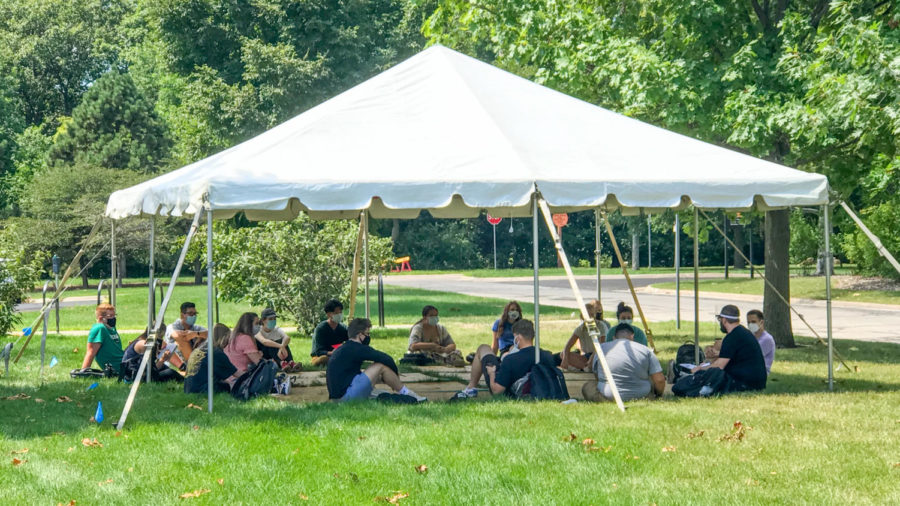Iowa State community reviews an unconventional academic year
Students sit in the shade of a tent outside the design building while wearing masks and sitting 6 feet apart.
April 28, 2021
This past year at Iowa State University has posed many unfamiliar challenges to both staff and students. The rampant coronavirus forced the university to alter many aspects of campus life in order to provide a safe place for students to focus on academics.
Among the changes to campus life were a reduced amount of organized on-campus gatherings, limited access to big sporting events and, most significantly, the new asynchronous format many courses followed.
“Online classes had their drawbacks and benefits,” Graham Bridges, a freshman majoring in aerospace engineering, said. “One benefit of asynchronous learning was that you could pick your own deadlines and your own schedule, so for some people I feel like that really worked out.”
Some students seemed to thrive in this structureless format of classes while others craved more structure and guidance.
“I think doing coursework online was super weird, I’ve never really had to do it before,” Brookelyn George, freshman in pre-business, said. “I feel like I fall behind super easily in the classes that don’t have a scheduled timeline that you just do at your own pace.”
Another issue some reported struggling with was the feeling of being trapped or isolated from other students.
“COVID-19 limits your resources a little bit, so it felt really easy to be trapped in your dorm room a lot. I think that’s the start of a little bit of the downs,” Bridges said. “Feeling trapped was the biggest thing I struggled with. When you’re trapped you see people a lot less and that’s a big deal.”
Some students felt this social gap in their college experience throughout the year while others took advantage of opportunities for community involvement offered through the university.
“I joined a sorority so I was able to make some good friends and good connections,” George said.
Other students used more creative outlets for social interaction, like Julian Totton, a senior in communication studies at Iowa State.
“I do standup comedy and the improv group,” Totton said. “We did shows in Curtiss [Hall] that did pretty well. We still get a decent chance at getting out into the community as long as we get the approval first.”
Not only did students need to adapt to this new style of education, but professors did as well. Angela Powers, a professor in the Greenlee School of Journalism and Mass Communication, was able to balance the restrictions of online teaching while still making in-person connections with her students.
“I found the combination of face to face and Webex in the hybrid format to facilitate learning,” Powers said. “It demanded more prep time and organization but was worth it to keep students in class and moving forward during the pandemic.”
While some aspects of socially distanced learning went off without a hitch, technological difficulties occasionally brought Zoom meetings to a halt.
“I would have liked to have a technology expert available to ensure all technological issues went well during class but realized this was not possible,” Powers said. “So learning the new technology was a challenge. But the students were great and would pitch in when there were technology glitches.”
Next year is planned to be far closer to a normal year with course delivery, as well as other aspects of campus life, returning to their traditional form.
“We are looking forward to the upcoming academic year with expectations that our vibrant residential campus will return to pre-pandemic levels for in-person classes, services, administrative support functions, research, operations, and activities,” Iowa State announced in a letter from President Wendy Wintersteen.
Undoubtedly, this year at Iowa State has been strange. The altered aspects of university life may not have been ideal but offered many learning opportunities. As the campus returns to a prepandemic state, it can hopefully continue to implement some of the strategies it has developed this year.

















